The quena flute, an ancient Andean instrument with a hauntingly beautiful sound, has been captivating audiences for centuries. Originating from the indigenous peoples of South America, particularly the Andean region, the quena has a distinct construction and playing technique that sets it apart from other flutes. In this article, we will provide a comprehensive guide for beginners on how to play the quena flute, exploring its unique features and offering step-by-step instructions to help aspiring musicians embark on their quena-playing journey.
Understanding the Quena: A Brief Introduction
The quena is traditionally made from bamboo or cane, featuring six finger holes and a thumb hole. Its design includes a tapered bore, which contributes to its distinctive sound quality. Unlike Western flutes, the quena is played with the lower lip covering the embouchure hole, creating a unique playing technique. Mastering the quena requires an understanding of its construction, playing posture, and specific fingerings.
Getting Acquainted with Your Quena: Anatomy and Maintenance
Before diving into playing the quena, it’s crucial to familiarize yourself with its anatomy. Ensure that your quena is in good condition, free from cracks or damage that could affect its sound quality. The embouchure hole should be clean, and the finger holes unobstructed. Additionally, familiarize yourself with the placement of the finger holes and the thumb hole, as correct finger positioning is essential for producing accurate notes.
Embracing the Quena Technique: Embouchure and Finger Placement
The quena’s unique playing technique involves using the lower lip to cover the embouchure hole partially. This distinctive embouchure creates a warm and resonant tone. Experiment with the angle and pressure of your lower lip until you achieve a clear and steady sound. As for finger placement, practice covering and uncovering the six finger holes and the thumb hole with precision. Consistent and controlled finger movements are essential for producing accurate pitches.
Mastering the Scale: Sa Re Ga Ma on the Quena
Begin your quena-playing journey by focusing on the basic scale—Sa Re Ga Ma, equivalent to the Western notes C, D, E, and F. Start by playing each note individually, ensuring a clear and distinct sound for each pitch. Pay attention to the nuances of the quena’s tonal quality and experiment with breath control to achieve varying dynamics. Practice ascending and descending scales, gradually building speed and fluidity in your transitions.
Exploring the Quena’s Range: Octaves and Registers
The quena offers a diverse range, allowing musicians to explore different octaves and registers. Experiment with playing Sa Re Ga Ma in higher and lower octaves, discovering the instrument’s full sonic potential. Adjust your breath control and embouchure to maintain clarity and stability across the quena’s entire range. This exploration will not only enhance your familiarity with the instrument but also contribute to the expressive possibilities in your playing.
Introduction to Traditional Melodies: Folk Tunes and Popular Quena Repertoire
To deepen your connection with the quena, explore traditional melodies and folk tunes. Many South American cultures have a rich repertoire of quena music that reflects their heritage and storytelling traditions. Start with simple folk tunes and gradually progress to more intricate compositions. Immerse yourself in the cultural context of the quena, understanding the stories and emotions behind each melody. This connection will add depth and authenticity to your quena-playing experience.
Rhythmic Accompaniment: Integrating Percussive Techniques
In addition to melody, the quena can incorporate rhythmic elements through percussive techniques. Experiment with techniques such as tongue stops and percussive breaths to add rhythmic accents to your playing. These techniques are integral to traditional Andean music, enhancing the overall expressiveness of the quena. Incorporate rhythmic patterns into your practice sessions, gradually building the coordination needed to seamlessly integrate percussive elements into your playing.
Seeking Guidance: Quena Lessons and Community
While self-learning is valuable, seeking guidance from experienced quena players or taking lessons from a qualified instructor can significantly accelerate your progress. Joining a quena community, whether in person or online, provides opportunities to exchange tips, share experiences, and gain insights from fellow enthusiasts. The collective knowledge of a supportive community can be invaluable in your journey to mastering the quena.
See Also: How Many Notes Can a Flute Play: Things You Need To Know
Conclusion: The Artistry of Quena Playing
In conclusion, playing the quena is a unique and rewarding experience that requires dedication, patience, and a deep appreciation for its cultural roots. By understanding the quena’s construction, mastering its playing technique, and exploring traditional melodies, beginners can embark on a journey of musical discovery. Regular practice, experimentation, and engagement with the quena community will contribute to the development of a distinctive and expressive quena-playing style. Embrace the artistry of the quena, and let its hauntingly beautiful tones transport you to the rich cultural landscapes of the Andean region.


